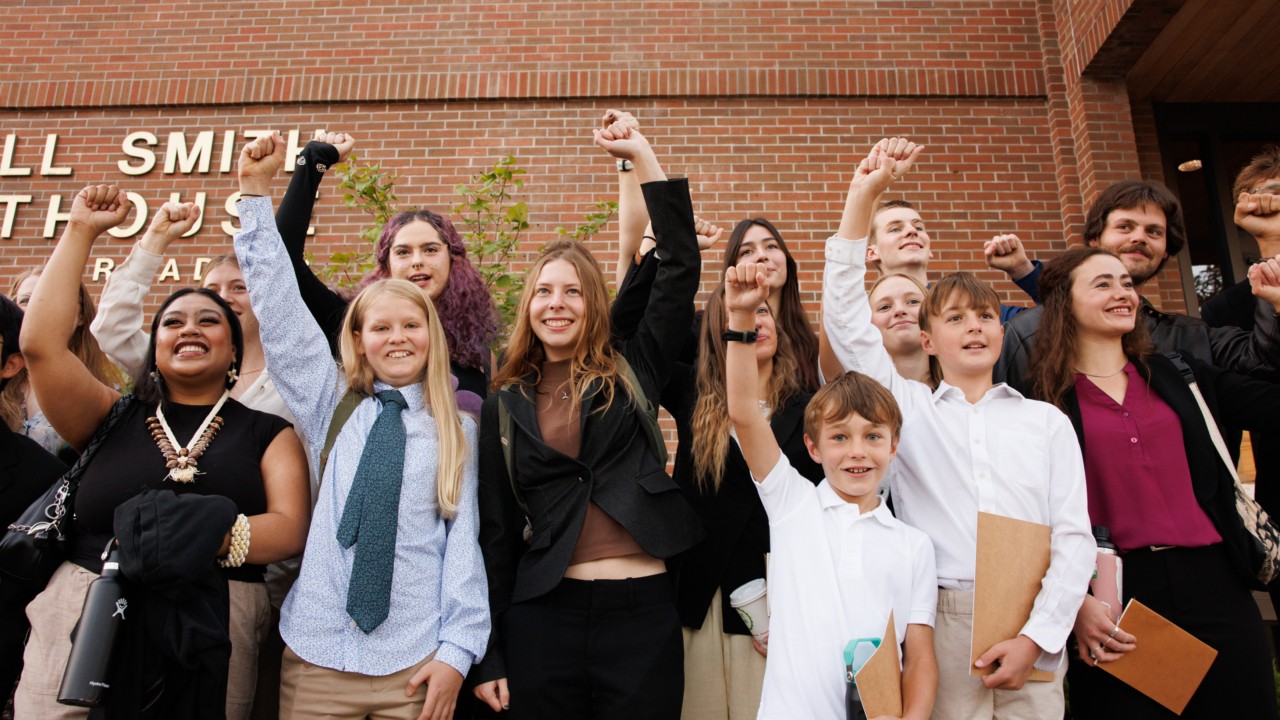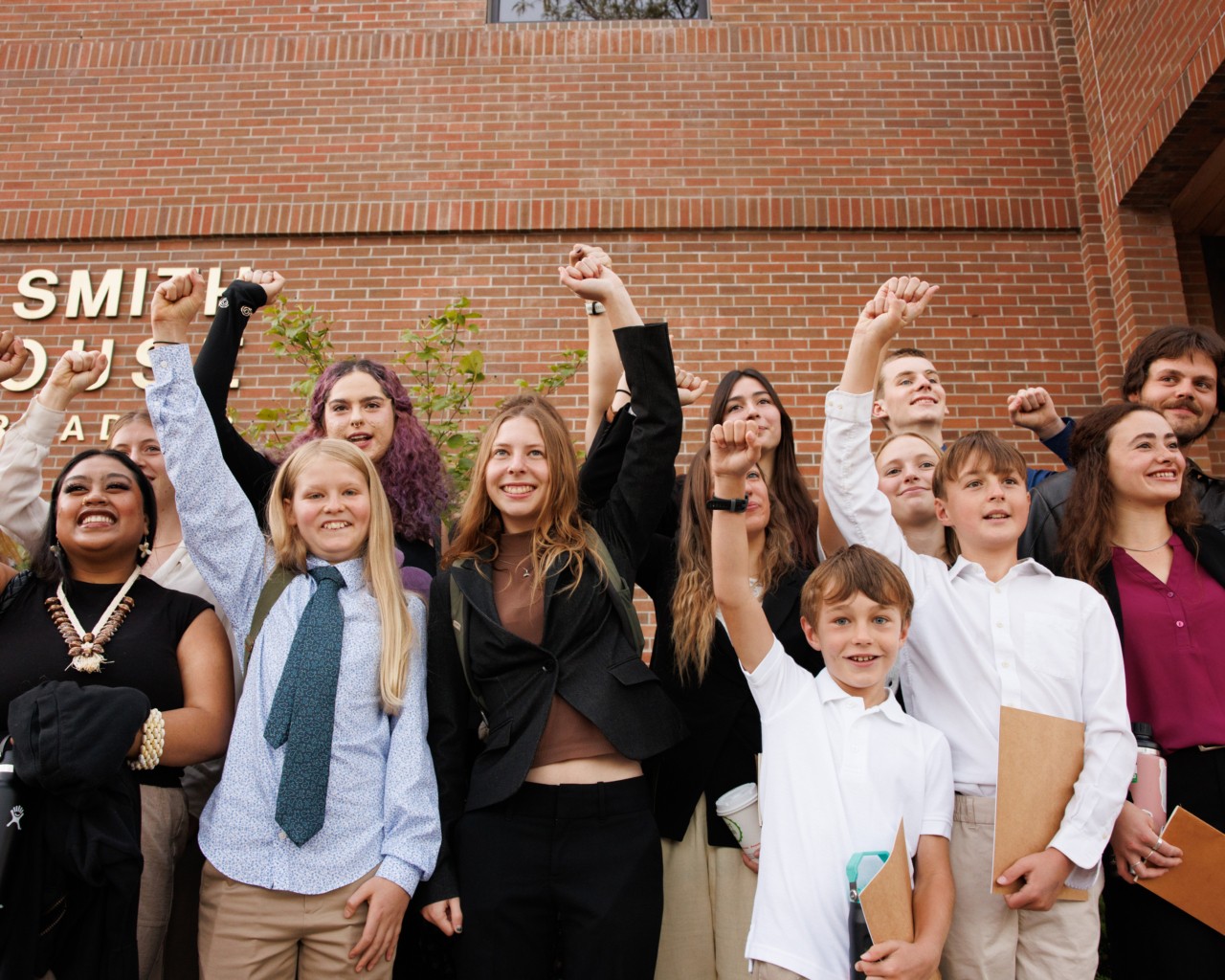

Photograph by John Stember, in collaboration with Montana Free Press
WORDS BY TYLER MCBRIEN
Does the United States Constitution guard against executive abuses of power that deprive children and youth of their fundamental rights to life and liberty?
That was the fundamental question Julia Olson, an attorney and the founder of Our Children’s Trust, posed to Judge Dana Christensen this week during a two-day hearing in a federal courthouse in Missoula, Montana.
The case, Lighthiser v. Trump, began in May when 22 young climate activists, aged 7 to 25, filed a lawsuit in the District of Montana asking the court to declare three Trump administration executive orders unconstitutional and prevent their implementation. The plaintiffs say the orders show the Trump administration’s intention to increase fossil fuel development, block renewable energy, and terminate congressionally mandated climate change science and research—all “under the false claim of an energy emergency, while the true emergency is that our fossil fuel-based energy system is polluting the air, water, lands, and climate on which Plaintiffs’ lives, liberties, and personal security depend.”
In some ways, Lighthiser v. Trump is the logical next step for OCT and the U.S. climate litigation movement, which aims to compel the government to take meaningful action to address the climate crisis—or prohibit it from making the crisis worse—through the judiciary. The lawsuit follows two of OCT’s recent wins, Held v. Montana and Navahine v. Hawaii Department of Transportation, and “further builds American constitutional jurisprudence on fossil fuel activities infringing the fundamental rights of youth,” according to the nonprofit law firm.
In other ways, Lighthiser is unlike anything that has come before. For one, this week’s hearing marked the first time a U.S. federal court heard live testimony in a constitutional climate change case. And, as Mat dos Santos, co-executive eirector and general counsel of OCT, told me, “Lighthiser goes beyond the traditional climate cases that Our Children’s Trust is famous for, because it’s really a case about our democracy and whether this president has the power to act on his own initiative without any regard for how that power was supposed to be divided up amongst the other branches of government.”
For dos Santos, Lighthiser is a linchpin because this administration’s threats to democracy have only grown more acute as the climate crisis reaches a breaking point. “The backdrop to Lighthiser is this fundamental principle about democracy that we’re seeing tested here and frankly across a number of [Trump’s] orders,” they said.
“Lighthiser goes beyond the traditional climate cases that Our Children’s Trust is famous for, because it’s really a case about our democracy.”
The young climate activists in June filed a motion for a preliminary injunction, which courts can issue in the early stages of legal proceedings to prevent irreparable harm while the outcome of a case is pending, among other reasons. The plaintiffs in Lighthiser asked the court to order the federal government to immediately halt implementation of the three orders, which direct federal agencies to “unleash” American energy, declare a “national energy emergency,” and purport to reinvigorate America’s coal industry, while the case plays out.
The government, for its part, wants the judge to dismiss the case entirely. In August, lawyers for the Trump administration filed a motion arguing the court lacked jurisdiction and the plaintiffs failed to lay out exactly how the court could craft an order to remedy their claims of harm.
The litany of defendants—more than a dozen government agencies in addition to President Trump—reflects just how widespread the administration’s anti-climate policies are distributed throughout the government. That list grew even longer when the judge allowed a coalition of 19 states and Guam to intervene in the case and join the federal government as defendants. OCT pointed out in a press release that among the over 450 cases filed against the second Trump administration thus far, Lighthiser is the only one in which a coalition of states has sought to intervene—“a clear sign that this youth-led lawsuit poses the greatest threat to the fossil fuel expansion policies of this administration.”
To aid in his decision, Judge Christensen convened this week’s hearing for the plaintiffs to make their case for a preliminary injunction, while the government tried to counter it. The latter party declined to call any witnesses of its own, even though they were permitted to do so. “The government isn’t even trying to rebut the plaintiffs’ scientific case about the causes and impacts of climate change,” said Michael Gerrard, the founder and director of Columbia University’s Sabin Center for Climate Change Law, who is not involved in the case. “If they could, they would call their own expert witnesses; but they realize this would be futile. Instead, they are relying entirely on legal arguments about the limited power of the courts.”
Across two days of testimony on Tuesday and Wednesday, the plaintiffs, alongside expert witnesses who appeared on their behalf, told stories of lives upended and dreams deferred by environmental damage. To dos Santos, the most heartwrenching moment came from one of the youngest plaintiffs, an 11-year-old identified in court filings by only his initials, J.K. The boy recounted how he found his younger brother breathing shallowly and laboriously, and how his parents took him to the hospital for several days due to the impact of air pollution on his lungs.
“When you have a legislature and an executive branch who refuse to do anything about the problem and even continue to make it worse, where else can we turn but the judicial branch of our government?”
Florida resident and fellow Lighthiser plaintiff Delaney Reynolds told me she found J.K.’s story “absolutely heartbreaking.” The 25-year-old Miami resident, who has been involved in several climate litigation cases bearing her name as plaintiff, highlighted how intertwined the crises of democracy and climate change are. She thinks their antidotes are linked, too: “When you have a legislature and an executive branch who refuse to do anything about the problem and even continue to make it worse, where else can we turn but the judicial branch of our government?”
Judge Christensen may not issue a ruling for a week or longer, but Reynolds and dos Santos are hopeful that the decision will tip in their favor after witnessing the plaintiffs’ and experts’ powerful testimony, the judge’s reactions and questions, and what they view as the relative weakness of the government’s legal strategy.
Even a loss on this motion could help inform future cases. At the end of the hearing, Olson urged the court to look to the past for inspiration and “do what judges did back in the 1950s in cases like Brown v. Board of Education,” when they dismantled policies of racial segregation by measuring them against the Constitution, even when judges could not look to past precedent to guide their decision.
While Olson looks to the past, dos Santos keeps his eyes trained on the future. “We have to keep fighting these fights in court and make sure that we’re getting this into the record so that hopefully when the next administration comes, when the court changes, they have a roadmap for how to correct this problem,” they said.
Reynolds remains content with the present, overlapping crises and all. She described to me the “overwhelmingly joyous” atmosphere walking into the courtroom this week for the hearings, through crowds holding up signs of support and shouting her name and the names of her fellow plaintiffs into bullhorns.
“It was an incredible experience to be able to walk through that,” she said. “And then hanging out with my friends and fellow plaintiffs throughout the day, there’s a lot of hope. There’s a lot of laughter.”
“Despite all the heavy material that we’re talking about in the courtroom,” Reynolds said, “everybody just has so much hope in our justice system and for the future of our planet.”
Correction,
September 22, 2025 9:27 am
ET
This story was edited to reflect that Mat Dos Santos is co-executive director and general counsel at Our Children's Trust, not counsel of record in this case.
The Youth Activists Suing Trump Are Fighting Climate Change and Authoritarianism